Developing better psychotherapy methods and techniques to increase impact, is akin to building better wings and more feathers to fly.
We have made an attribution error.
Recall the history of mankind’s attempts to fly.[1] Early observers found strong correlations between the ability to fly and possessing feathers and wings. Dating back hundreds of years, men were documented to have strapped wings on their backs and jumped off hills, cliffs, and cathedrals.
Here’s what Professors Clayton Christensen[2] noted about this attribution error. In humanity’s attempts to follow what they believed were “best practices,”
“…they failed…The mistake was that although feathers and wings were correlated with flying, the would-be aviators did not understand the fundamental causal mechanism—what actually causes something to happen—that enabled certain creatures to fly.”
“The real breakthrough in human flight didn’t come from crafting better wings or using more feathers. It was brought about by Dutch-Swiss mathematician Daniel Bernoulli and his book Hydrodynamica, a study of fluid mechanics. In 1738, he outlined what was to become known as Bernoulli’s principle, a theory that, when applied to flight, explained the concept of lift. We had gone from correlation (wings and feathers) to causality (lift). Modern flight can be traced directly back to the development and adoption of this theory.”
Christensen points out, “The appeal of easy answers—of strapping on wings and feathers—is incredibly alluring.”
Applying new methods learned from workshops without gasping of principles at play, is like “strapping on wings and feathers” and expecting flight to happen.
The Einstellung Effect
In some aspects, our approach to getting better at psychotherapy is like playing Russian nesting dolls, almost never quite getting out of this metaphorical box. This way of thinking—sometimes referred to as the Einstellung effect[3], a psychology term for the tendency of problem solvers to employ only familiar methods even if better ones are available—can become a rather frustrating process. The frustration is akin to trying to peddle your bike at full tilt with wonky gears that are slightly disengaged from the wheels.
Dismantling Studies
If one examines some brilliant dismantling studies in therapy, that is, studies that compare discrete components of a therapy, we would find that we make the same conflation about feathers and wings and flying. For instance, in a seminal study by Neil Jacobson and colleagues (1996). cognitive therapy for depression does not need the cognitive components. More evidence: Cognitive processing therapy for PTSD does not need the cognitive processing or the writing components (Resick et al., 2008), and CBT for PTSD does not need cognitive restructuring (Foa et al., 2005).[4] These studies point towards the need for us to seek the counterfactuals (See this blog post What Have You Change Your Mind About), and understanding first principles before methods. [5]
Let’s zoom out and examine how our attempts to get better look like. If the body of research tells us anything, in my estimation, it might look like this:

See Related Post:
The Music of Psychotherapy: Learning in A Wicked Environment
Outside Looking In
For all that he has contributed to our understanding of the world, I was surprised to learn that Charles Darwin was considered a “professional outsider.”[6] He was neither a university faculty member nor a scientist in any institution, though he was connected to the scientific community.
What if we learn to see slightly beyond the world of therapy, and step outside and look into the world of the what creates impact, promotes change and growth, from the eyes of those who might benefit from help? What if our paradigms and metaphors go beyond forms of psychotherapeutic persuasions that we know in our playbook, and look at domains in ancient wisdom, spirituality, performing arts and beyond, so that we can create better impact in sessions?
Here’s a more direct implication: When you are trying to use ideas of deliberate practice into your work, look beyond deliberately practicing in the domain of “The world of psychotherapy,” (Getting better in your preferred model of therapy), which has marginal returns and impact on clients. Instead, look at the target domain “the world of people seeking help” and work your way backwards. (Once again, look at the diagram above before you go).
Footnotes:
[1] Check out some interesting old footages here. And more.
[2] The Measure of Your Life by Clayton Christensen.
[3] Psychologist Bjørnar Fauske Bye said to me, “So there’s a name for this. We all need an alibi.” I love his comment about this!
[4] See these two brilliant papers debating the between specific vs common factors. I suggest reading these in the following sequence:
a. The Dodo Bird, Treatment Technique, and Disseminating ESTs (Behaviour Therapist Siev 2009)
b. Barriers to the Dissemination of Empirically Supported Treatments/ Matching Messages to the Evidence(Behavior Therapist Wampold Imel Miller 2009)
[5] In the book Unlocking the Emotional Brain (Chapter 6), Bruce Ecker and his colleagues does a good job showing common core principles at work amongst several therapy models (EFT, Coherence Therapy, EMDR, Interpersonal Neurobiology, AEDP).
[6] See Origins of Genius by Dean Simonton (Oxford: Oxford University Press, 1999). I first come upon this in the book Range, by David Epstein. I have to admit, learning about Darwin’s lack of association with any university made me feel less bad about myself, since I’m not affiliated to any academic setting.



Thanks for this – hit the spot as always. Sense at times our profession is pushing us to get more feathers vs learning to fly. Personally I have gathered so many feathers it looks like there has been a cosmic pillow fight – now to find some clarity and see how I can use them to help me fly.
ha! Thanks for your comment! As i’ve mentioned in our other correspondence, “cosmic pillow fight” totally cracked me up!